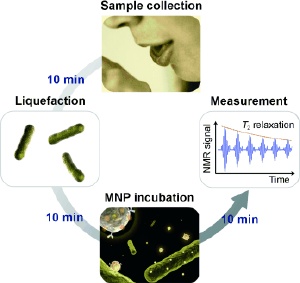Jul 29 2009
Many of the new techniques based on nanotechnology that have been developed for faster and more sensitive detection of pathogens fail in day-to-day clinical use because they require complex sample preparation or measurement equipment, or simply cannot keep up with the large sample throughput in a clinic. Researchers working with Ralph Weissleder at Harvard Medical School have now developed a very simple process for the rapid detection of pathogens that requires no further sample preparation. As reported in the journal Angewandte Chemie, this technique is based on magnetic nanoparticles and a nuclear magnetic resonance (NMR) measurement.
 © Wiley-VCH
© Wiley-VCH
For their tests, the researchers used the bacillus Calmette-Guérin (BCG), a mycobacterium named after its developers, which was cultured from bovine tuberculosis bacilli in the early twentieth century. This is a weakened strain that is used as a live vaccine against tuberculosis. In addition, it serves as a model for the true tuberculosis pathogen Mycobacterium tuberculosis for research purposes.
The test is this simple: A sample is incubated in a solution that contains special magnetic nanoparticles. These nanoparticles consist of an iron core surrounded by a shell of ferrite, which is an iron oxide. The researchers attached anti-BCG antibodies to the surfaces of the nanoparticles. If BCG bacteria are present in the sample, the antibodies bind to them, thus equipping them with magnetic particles. The liquid is then introduced through microchannels into the tiny chamber of a microfluidic chip. At the exit of the chamber is a membrane that retains the bacteria while the rest of the solution, including excess magnetic particles, passes through. The bacteria thus become concentrated in the chamber.
The chamber is surrounded by a small coil, which produces the magnetic field required for nuclear magnetic resonance measurements (similar to a clinical MRI scanner). The bacteria, with their attached magnetic particles, influence the behavior of the nuclear spins of the water molecules in the chamber. This can be detected directly on the chip by means of the handheld miniaturized NMR system. It was thus possible to detect 20 bacilli in a sputum sample within 30 minutes.